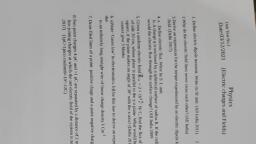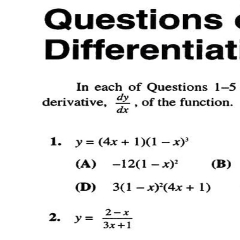Question 1 :
<span class="wysiwyg-font-size-small"><span class="wysiwyg-font-size-small"><p class="wysiwyg-text-align-left">Fill in the blank.</p><p class="wysiwyg-text-align-left">$1$ Coulomb of charge contains_______number of electrons.</p>
Question 2 :
A positive charge $q$ is placed in a spherical cavity made in a positively charged sphere. The centers of sphere and cavity are displaced by a small distance $\vec {l}$. Force on charge $q$ is:<br>
Question 3 :
The specific charge of a proton is $9.6 \, \times \, 10^7 \, C \, kg^{-1}$ The specific charge of an alpha particle will be
Question 4 :
Complete the following statements with an appropriate word /term be filled in the blank space(s).<br/>The force of attraction or repulsion between two charges is given by ......................<br/>
Question 7 :
The force acting between two point charges kept at a certain distance is $5$N. Now the magnitudes of charges are doubled and distance between them is halved, the force acting between them is _________ N.
Question 8 :
If electrical force between two charges is $200 N$ and we increase $10$% charge on one of the charges and decrease $10$% charge on the other, then electrical force between them for the same distance becomes :<br>
Question 9 :
The electric potential is $V=x^2-2x$. What us the electric field strength at $x=1?$
Question 11 :
A neutral rubber rod and a neutral piece of fur have equal amounts of negative and positive charge. When the fur is rubbed against the rod, a transfer of electrons occurs. The transfer of electrons and mass transfer respectively takes place from
Question 13 :
Two positive point charges $q$ are placed at  $(a,0)$ and $(-a,0)$. A third positive charge $q_o$ is placed at $(0,y)$. For what value of $y$, the force on $q_o$ is maximum?
Question 15 :
Two charges $9e$ and $3e$ are placed at a separation $r$. The distance of the point where the electric field intensity will be zero, is-
Question 16 :
The force of repulsion between two point charges is $F,$ when these are$1{\text{ }}m$ apart. Now the point charges are replaced by conducting spheres of radii$5{\text{ }}cm$ having the charge same as that of point charges. The distance between their centres is$1{\text{ }}m,$ then the force of repulsion will:
Question 18 :
State whether true or false.<br/>Ebonite is a good conductor of electricity.<br/>
Question 19 :
A certain charge Q is divided into two parts q and $Q-q$. How the charge Q and q must be related so that when q and $(Q-q)$ is placed at a certain distance apart experience maximum electrostatic repulsion?
Question 20 :
Surface density of charge on a sphere of radius $R$ in terms of electric intensity $E$ at a distance $r$ in free space is :<br/>(${\varepsilon}_{0} =$ permittivity of free space) 
Question 22 :
A solid sphere of radius $R$ has a charge $Q$ distributed in its volume with a charge density $\rho = kr^{a}$, where $k$ and $a$ are constants and $r$ is the distance from its centre. If the electric field at $r = \dfrac {R}{2}$ is $\dfrac {1}{8}$ times that at $r = R$, the value of $a$ is
Question 23 :
Charges $Q_1$ and $Q_2$ lie inside and outside respectively of a closed surface S. Let E be the field at anypoint on S and $\phi$be the flux of E over S
Question 24 :
A point charge $q$ is placed at a point on the axis of a non-conducting circular plate of radius $r$ at a distance $R (R >> r)$ from its center. The electric flux associated with the plate is :<br/>
Question 25 :
Electric flux through a surface of area $100\ m^{2}$ lying in the xy plane is (in V-m) if $\vec{E}=\hat{i}+\sqrt{2}\hat{j}+\sqrt{3\hat{k}}$<br/>
Question 26 :
Mathematically, electric flux can $\phi$be represented as:<br><br>$\vec E =$ electric field<br>$\hat n=$ surface normal vector<br>$A=$ surface area
Question 28 :
Two parallel large thin metal sheets have equalsurface charge densities$\displaystyle \left( \sigma =26.4\times { 10 }^{ -12 }{ c }/{ { m }^{ 2 } } \right)$ of opposite signs.<br>The electric field between these sheets is:<br><br>
Question 29 :
Assertion: STATEMENT-1 : In a region where uniform electric field exists, the net charge within volume of any size is zero.
Reason: STATEMENT-2 : The electric flux within any closed surface in a region of uniform electric field is zero.

























